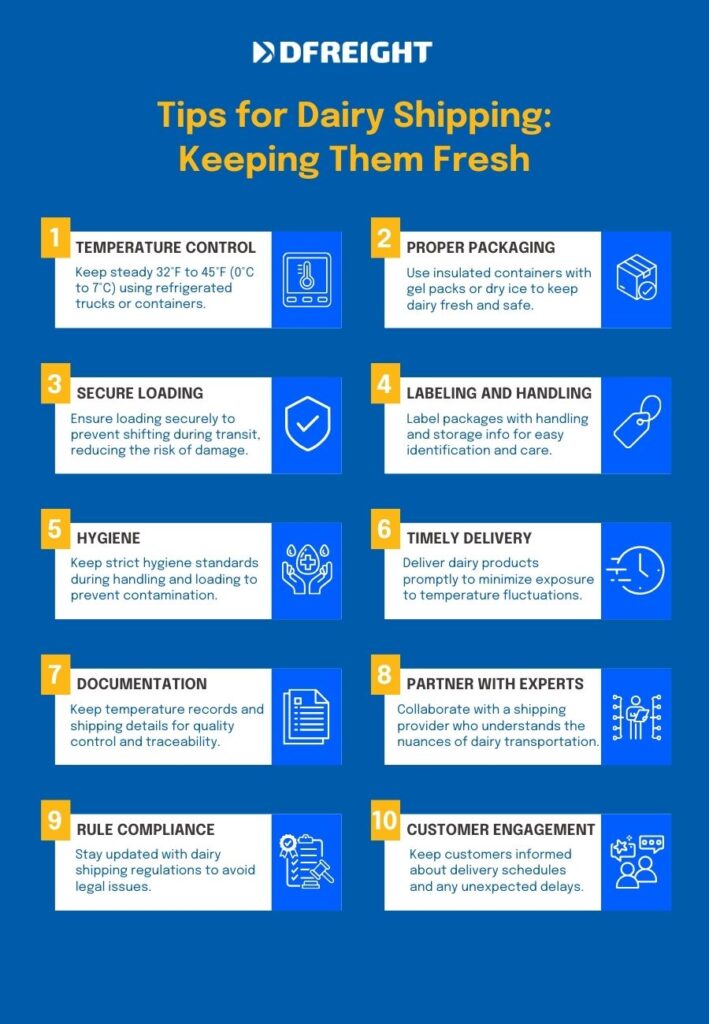Dairy shipping is the process of transporting dairy products from one location to another. Dairy products are perishable and require special care when shipping. There are many different dairy shipping services available, and it is important to choose the right one for your needs. This guide will provide you with everything you need to know about dairy shipping, including the benefits, how to ship dairy products, and tips for choosing the right shipping service.
Table of Contents
Why Dairy Shipping is Important
Dairy shipping is an important process in the food industry as it helps to ensure that dairy products are delivered fresh and unspoiled to consumers. This is essential in maintaining the quality of dairy products and ensuring that they are safe for human consumption. Dairy shipping also helps to protect the environment by preventing dairy products from becoming contaminated with harmful bacteria or other contaminants. This products are perishable and need to be kept cool and fresh during transport. Dairy shipping can be challenging, but it is important to ensure that the products arrive at their destination in good condition.
Dairy shipping is vital for many reasons. It helps dairy shipping from farms to grocery stores, and it also helps to keep these products fresh. It creates jobs in the shipping industry and helps provide fresh dairy products to people who live in cities and other areas without dairy farms. Dairy products are perishable, so they must be shipped quickly and efficiently to stay fresh. Dairy shipping also helps to create jobs for people who work in the shipping industry. Shipping dairy products is a complex process, and it requires the use of special equipment and vehicles. Shipping companies specializing in dairy shipping can provide these services to farms and grocery stores.
In the dairy industry, logistics plays a vital role in ensuring that products reach consumers in a timely and efficient manner. By managing the transportation and storage of dairy products, logistics professionals are able to keep the supply chain running smoothly and ensure that products are of the highest quality when they reach consumers. In recent years, the dairy industry has become increasingly globalized, with producers and processors operating in countries around the world. This has created a need for more sophisticated logistics systems that can manage the movement of dairy products across long distances and multiple borders.
In order to meet the challenges of the global dairy industry, logistics professionals must be able to effectively plan and coordinate the transportation of products from farm to market. They must also have a thorough understanding of the regulatory environment in which they operate, as well as the unique needs of the dairy industry. By working closely with producers, processors, and retailers, logistics professionals can ensure that the dairy industry runs smoothly and that products are of the highest quality when they reach consumers.
The dairy shipping provides a number of benefits to both producers and consumers of dairy products.
- For producers, the supply chain provides a way to get their products to market quickly and efficiently. It also allows producers to track their products from farm to table, which is important for food safety and quality control.
- For consumers, the supply chain provides a reliable source of safe and high-quality dairy products. It also gives consumers the ability to choose from a wide variety of dairy products, all of which are produced to the same high standards.
- Provides employment for thousands of people.
- Helps to keep dairy products fresh and safe for consumption.
The dairy shipping industry faces many challenges, both in terms of the products it produces and the logistics of getting those products to consumers.
- One of the biggest challenges facing the dairy shipping industry is the increasing global demand for dairy products. As the world population continues to grow, so does the demand for milk and other dairy products. In order to meet this demand, dairy shipping producers and processors must find ways to increase production and efficiency.
- Another challenge facing the dairy shipping industry is the increasing cost of transportation. As fuel prices rise, the cost of dairy shipping around the world also increases. This puts pressure on the industry to find ways to reduce transportation costs, while still ensuring that products reach consumers in a timely and efficient manner.
The dairy shipping industry must also deal with the challenges posed by changing consumer preferences. As more people become health conscious, they are seeking out dairy products that are lower in fat and calories. This trend presents a challenge for the industry, as it must find ways to produce products that meet the changing demands of consumers. Despite the challenges it faces, the dairy shipping industry continues to be a vital part of the global food supply. By working together to address these challenges, the industry can ensure that it will continue to provide a high-quality product to consumers around the world.
The Dairy Shipping Process
Although the worldwide shipping of dairy products has been going on for centuries, the modern process is quite different. In the past, dairy products were shipped in barrels or other containers that were not refrigerated. This meant that the products often spoiled during the journey. Today, however, refrigerated shipping containers are used, which helps to keep the products fresh. The dairy industry is a very important part of the economy, and the shipping of dairy products plays a big role in that. Every year, billions of dollars worth of dairy products are shipped around the world. This includes things like milk, cheese, and butter. The shipping of these products is a big business, and it employs a lot of people.
In the dairy product supply chain, raw milk is first collected from dairy farms. This milk is then transported to dairy processing plants where it is pasteurized and made into various dairy products. From there, the dairy products are shipped to grocery stores, restaurants, and other customers. The dairy product supply chain is a complex and interconnected system that is essential to the production and distribution of dairy products. Every step in the process, from dairy farming to processing to distribution, plays a critical role in ensuring that dairy products are safe and of high quality.
The safety and quality of dairy products is of paramount importance. In recent years, there have been a number of food safety scandals involving dairy products. For example, in 2008, contaminated milk from China caused the death of six infants in that country. In 2011, a listeria outbreak in Europe was linked to contaminated cheese. These incidents underscore the importance of maintaining a high level of food safety throughout the entire dairy product supply chain. All players in the supply chain, from farmers to processors to distributors, must take steps to ensure that dairy products are safe and of the highest quality.
The dairy product supply chain is a complex system, but it is one that is essential to the production and distribution of safe and high-quality dairy products. The shipping of dairy products is not without its challenges, however. One of the biggest challenges is keeping the products fresh during the journey. This is because dairy products are perishable and need to be kept at a certain temperature. If the products are not kept at the right temperature, they can spoil. This can be a big problem, because it can lead to food poisoning.
Another challenge is dealing with customs regulations. Every country has its own rules about what can and cannot be shipped into the country. This can make it difficult to ship dairy products from one country to another. Despite the challenges, the shipping of dairy products is a big business, and it is likely to continue to grow in the future. This is because the demand for dairy products is increasing all over the world. As more and more people learn about the benefits of dairy products, they are likely to want to buy them. This will keep the shipping industry busy for years to come.
Cold supply chains are responsible for transporting dairy products from farms to processing plants, and then to retailers and consumers. Without a cold supply chain, dairy products would not be able to maintain their quality and freshness. This requires the use of specialized equipment, such as refrigerated trucks and storage facilities. The shipping of dairy products is also a time-sensitive process, as products must be delivered to processing plants as quickly as possible after they are produced. Without a cold supply chain, dairy products would not be able to reach consumers in a fresh and high-quality state.
The shipping process is complex because dairy products are perishable and must be kept cool during transport. This requires special equipment and careful planning. The process is also lengthy because dairy products must be shipped to different parts of the country (or even the world) and must often travel long distances.
Different Methods of Dairy Shipping
There are many different methods to transport dairy products, each with its own advantages and disadvantages. Here is a comprehensive guide:
- Rail transport is one of the oldest methods of transporting dairy products and is still used today. One advantage of rail transport is that it is very efficient, especially over long distances. Another advantage is that it is relatively cheap, especially when compared to air transport. However, one disadvantage of rail transport is that it is slow, which can be a problem when time is of the essence. Another disadvantage is that rail transport can be disrupted by bad weather, which can lead to delays.
- Road transport is the most common form of transport for dairy products. One advantage of road transport is that it is very flexible, which means that it can be used for short journeys as well as long ones. Another advantage is that it is relatively cheap. However, one disadvantage of road transport is that it is slow, which can be a problem when time is of the essence. Another disadvantage is that road transport can be disrupted by bad weather, which can lead to delays.
- Ocean transport is a very popular method of transporting dairy products, especially over long distances. One advantage of ocean transport is that it is very efficient. Another advantage is that it is relatively cheap. However, one disadvantage of ocean transport is that it is slow, which can be a problem when time is of the essence. Another disadvantage is that ocean transport can be disrupted by bad weather, which can lead to delays.
- Air transport is the fastest way to transport dairy products. One advantage of air transport is that it is very fast. Another advantage is that it is relatively safe. However, one disadvantage of air transport is that it is very expensive. Another disadvantage is that it can be disrupted by bad weather, which can lead to delays.
In conclusion, each method of transport has its own advantages and disadvantages. The most suitable method of transport will depend on the journey that is being made, the time frame that is available and the budget that is available.
Tips for Successful Dairy Shipping
There are a few key things to keep in mind when shipping dairy products around the world:
- Keep products cold: Dairy products are perishable and must be kept at a temperature below 40 degrees Fahrenheit at all times. This requires the use of refrigerated trucks and storage facilities.
- Time is of the essence: Dairy products must be delivered to processing plants as quickly as possible after they are produced.
- Use a reputable shipping company: Choose a shipping company that has experience in shipping dairy products around the world.
- Keep track of your shipment: Make sure to track your shipment so you know where it is at all times.

By following these tips, you can ensure that your dairy products will be shipped successfully around the world.
Overall
Most dairy products can be shipped without any special packaging, but there are a few things to keep in mind. First, make sure the products are well-sealed and protected from temperature changes. Second, ship dairy products in a way that will keep them cool, such as with dry ice or gel packs. Finally, be sure to label the products clearly so that the recipient knows how to store and handle them. By following these simple tips, you can ensure that your dairy products arrive fresh and delicious.
If you’re looking for a digital freight forwarder to help with your dairy shipping needs, look no further than DFreight! We’re here to help you every step of the way. Contact us for a free quote today!
What are the most common issues when shipping dairy products?
Common issues when shipping dairy products include spoilage, leaks, and damage to packaging.
How can I ensure my dairy products will arrive fresh?
To ensure dairy products arrive fresh, use proper packaging materials, store products properly prior to shipping, and adhere to shipping requirements.
What are the requirements for dairy shipping products?
Dairy product shipping requirements vary by country, but generally include proper labeling, packaging, and refrigeration.
What are the customs requirements for importing dairy products?
Customs requirements for importing dairy products vary by country, but may include an import permit, health certificate, and proof of origin.














